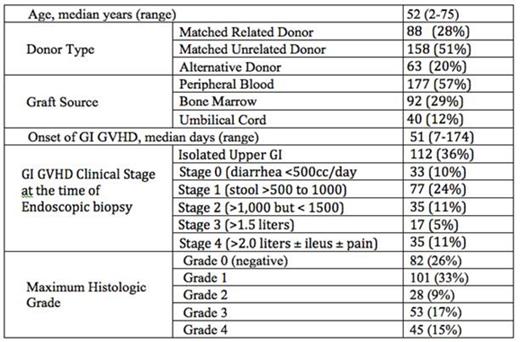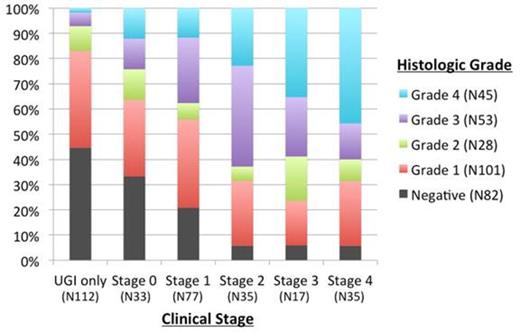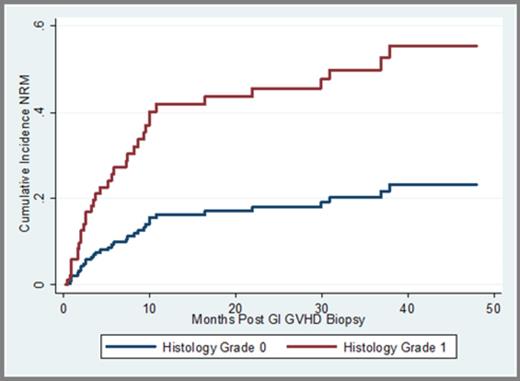Abstract
Introduction: Gastrointestinal Graft Versus Host Disease (GI GVHD) is a leading cause for non-relapse mortality (NRM) following allogeneic hematopoietic cell transplantation. Histologic confirmation of GI GVHD via endoscopic biopsy is considered standard practice with histologic grading reported as grades 0-4. Histologic grade 3-4 (crypt drop out/ broad areas of denudation) has been found to correlate with clinical severity and very high NRM. However, the prognostic value for the more common histologic grade 1 (increased apoptotic bodies) has been poorly described, leading to confusion in rendering therapy in patients with this finding. The goal of this study was to determine the impact on NRM for patients with histologic grade 1 in context of the presenting clinical stage.
Methods: We evaluated 309 consecutive patients who underwent an initial, histologic confirmation for suspected GI GVHD within the first 6 months post-transplant between the years of 2009- 2012 at MD Anderson. The majority of the patients underwent an upper GI endoscopy with random biopsies obtained from the antrum and body of the stomach and duodenum along with an un-prepped sigmoidoscopy with random rectal biopsies. All slides were re-reviewed by a single pathologist experienced in GI GVHD. The overall histologic grade for a patient was defined as the maximum grade identified in any biopsy site. The presence of 4 or more apoptotic bodies in a biopsy fragment was required for histologic grade 1, and a biopsy fragment with 3 or fewer apoptotic bodies (formerly suggestive of or cannot exclude GVHD) was classified as negative (histologic grade 0). In order to be considered as negative for GVHD, the absence of apoptotic bodies was required for all biopsy fragments. Clinical stage 0 refers to patients who underwent endoscopic biopsy for mild lower GI GVHD symptoms but not severe enough for clinical stage 1, and remainder clinical stages were defined based on standard criteria.
Results: Patient characteristics are described in Table 1. A total of 82 (26%), 101 (32%), 28 (9%), 53 (17%), and 45 (15%) patients were classified as having GI GVHD histologic grade 0-4, respectively. The distribution of histologic grade according to presenting clinical stage is shown in Figure 1. In univariate analysis, the presence of histologic grade 1 did not influence NRM for patients with isolated upper GI GVHD (HR 0.8, p=0.6), but was associated with increased NRM (HR 2.4, p=0.02) in patients with lower GI GVHD. Among patients with lower GI GVHD, the 4-years cumulative incidence (CI) of NRM was significantly higher in patients with clinical stages 3-4 versus 0-2 (61% vs 41%, p 0.002). However, the proportion of histologic grade 1 was comparable between these two groups (23% vs 32%, p=0.2). Therefore, we assessed the impact of histologic grade 1 in lower GI GVHD stratifying for clinical stage (0-2 vs 3-4). In univariate analysis, histologic grade 1 did not lessen the severity of GVHD in patients with clinical stage 3-4 (4-years % CI: 83%). In contrast, histologic grade 1 was associated with increased NRM in clinical stage 0-2 compared with histologic grade 0 (4-years % CI: 48% vs 18%). Multivariate competing-risk regression analysis confirmed the independent impact of histologic grade 1 in patients with clinical stages 0-2 (HR=3.05, p= 0.025) (Figure 2). The presence of multiple versus single positive biopsy site for histologic grade 1 did not influence NRM.
Conclusion: Histologic grade 1 GI GVHD is not synonymous with "mild" GVHD and clinicians should use the term "mild" only to reflect clinical stage. The presence of histologic grade 1 in patients presenting with lower GI GVHD clinical stage 0-2 should not be dismissed since it independently impacts outcomes with 3-fold increased NRM. For patients who present with advanced lower GI GVHD (clinical stage 3-4), the presence of histology grade 1 does not lessen the markedly adverse impact of advanced clinical stage GVHD.
Alousi:Therakos, Inc: Research Funding.
Author notes
Asterisk with author names denotes non-ASH members.




This feature is available to Subscribers Only
Sign In or Create an Account Close Modal